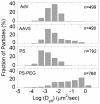Common gene therapy viral vectors do not efficiently penetrate sputum from cystic fibrosis patients
- PMID: 21637751
- PMCID: PMC3103503
- DOI: 10.1371/journal.pone.0019919
Common gene therapy viral vectors do not efficiently penetrate sputum from cystic fibrosis patients
Abstract
Norwalk virus and human papilloma virus, two viruses that infect humans at mucosal surfaces, have been found capable of rapidly penetrating human mucus secretions. Viral vectors for gene therapy of Cystic Fibrosis (CF) must similarly penetrate purulent lung airway mucus (sputum) to deliver DNA to airway epithelial cells. However, surprisingly little is known about the rates at which gene delivery vehicles penetrate sputum, including viral vectors used in clinical trials for CF gene therapy. We find that sputum spontaneously expectorated by CF patients efficiently traps two viral vectors commonly used in CF gene therapy trials, adenovirus (d∼80 nm) and adeno-associated virus (AAV serotype 5; d∼20 nm), leading to average effective diffusivities that are ∼3,000-fold and 12,000-fold slower than their theoretical speeds in water, respectively. Both viral vectors are slowed by adhesion, as engineered muco-inert nanoparticles with diameters as large as 200 nm penetrate the same sputum samples at rates only ∼40-fold reduced compared to in pure water. A limited fraction of AAV exhibit sufficiently fast mobility to penetrate physiologically thick sputum layers, likely because of the lower viscous drag and smaller surface area for adhesion to sputum constituents. Nevertheless, poor penetration of CF sputum is likely a major contributor to the ineffectiveness of viral vector based gene therapy in the lungs of CF patients observed to date.
Conflict of interest statement
Figures





References
-
- Griesenbach U, Geddes DM, Alton EW. Gene therapy progress and prospects: cystic fibrosis. Gene Ther. 2006;13:1061–1067. - PubMed
-
- Conrad CK, Allen SS, Afione SA, Reynolds TC, Beck SE, et al. Safety of single-dose administration of an adeno-associated virus (AAV)-CFTR vector in the primate lung. Gene Ther. 1996;3:658–668. - PubMed
-
- Rosenfeld MA, Yoshimura K, Trapnell BC, Yoneyama K, Rosenthal ER, et al. In vivo transfer of the human cystic fibrosis transmembrane conductance regulator gene to the airway epithelium. Cell. 1992;68:143–155. - PubMed
-
- Simon RH, Engelhardt JF, Yang Y, Zepeda M, Weber-Pendleton S, et al. Adenovirus-mediated transfer of the CFTR gene to lung of nonhuman primates: toxicity study. Hum Gene Ther. 1993;4:771–780. - PubMed
Publication types
MeSH terms
Substances
Grants and funding
LinkOut - more resources
Full Text Sources
Other Literature Sources
Medical

